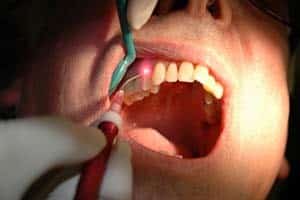Dentist in Gilbert: 5 Things to Know About the Torus Mandibularis
Last updated Friday, September 16th, 2022

What’s a torus mandibularis? You may not know it by name, but if you have one or two, you’ll know exactly what we mean when we say a bony growth on the mandible, right beside your tongue. They’re usually big hard lumps right beside your lower premolars. And if you are dealing with the presence of exceptionally large or bothersome torus mandibularis, we know you’d probably like them removed. At Smiles by Hanna, your dentist in Gilbert performs tori removal using the new Laser Waterlase and Peizotomes so healing is quick and painless. There are a lot of unknowns about the torus mandibularis. Here, we’ve put together the top 4 things you need to know about the bony growths and their removal.
#1: They Usually Exist in Pairs
The existence of torus mandibularis is not all too common — it’s estimated that 12 to 25% of the adult population has these bony overgrowths in the lower jaw. People who have this tori mandibularis usually have two, but they can exist on their own. 90% of tori exist in both sides of the mouth and they can be extremely uncomfortable when getting dental x-rays and or getting dentures or implants.
#2: Torus Mandibularis Are Associated with Bruxism
What causes the presence of torus mandibularis? People who have the bony growths usually clench their jaws or grind their teeth at night (the condition known as bruxism). It can be difficult to determine precisely why the tori show up, but genetic factors can also influence their development.
#3: They’re Not Cancer
When many people notice tori for the first time, they are worried that they have oral cancer. It is good to be aware of the risk of oral cancer, but the torus mandibularis are not cancerous. It may be difficult to identify what they really are on your own, though, so get in touch with Dr. Hanna’s office to have the bony growths checked out to be sure.
#4: Their Size May Fluctuate
Throughout a lifetime, the size of the tori may fluctuate. At their biggest, they can actually meet in the middle — and that means they’re really big. Especially large tori can get in the way of proper eating. Chips, crusty bread, and other crunchy foods present real difficulty. Food particles may become lodged in the tori, causing discomfort or bad breath.
#5: They Can Be Removed at Smiles By Hanna
When the bony growths present a problem or are large enough to inhibit proper eating, we may recommend removing them. Unlike the old fashioned way of removal with the knife, chisel and hammer. Dr. Hanna uses the Waterlase Laser and Peizotomes to remove the tori. It’s a simple procedure in which Dr. Hanna removes the excess bits of bone tissue to help return your smile to its normal state. However, many times, the tori can exist without issue in the mouth. We will evaluate the areas and determine whether or not their removal is recommended.
Schedule an Appointment Today!
If you have one or two bony growths in your lower jaw, you can have them removed! Dr. Mansoor performs tori removal for patients like you at Smiles By Hanna. Schedule an appointment to discuss the benefits of the procedure today.
Get Started On Your New Smile
It's time you stop putting off your next dental visit. Whether it's a general check-up or a complex restorative or cosmetic procedure, the time to book your appointment is now!

